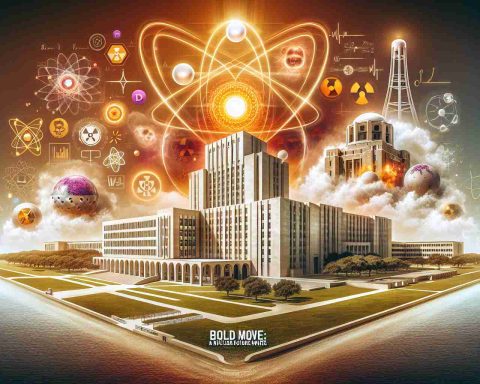- The Texas A&M University System is launching “The Energy Proving Ground” to explore small modular reactors (SMRs) at its RELLIS campus.
- Four developers, including Terrestrial Energy and Kairos Power, will conduct assessments and navigate regulations for SMR technologies.
- The project aims to connect up to 1 GW of nuclear power to the ERCOT grid by the early to mid-2030s.
- The initiative addresses increasing energy demands driven by advancements in AI and data centers.
- Partnerships with major corporations, such as Google, support the development of innovative nuclear solutions.
- This project positions Texas A&M as a pivotal player in advancing nuclear technology and energy innovation across the U.S.
In a groundbreaking move for the future of energy, the Texas A&M University System has unveiled an ambitious initiative to explore small modular reactors (SMRs) at its Texas A&M-RELLIS campus near College Station. This project, known as “The Energy Proving Ground,” aims to bring operational advanced reactors to Texas within the next five to seven years, igniting a new chapter in nuclear power.
The university has chosen four promising developers: Terrestrial Energy, Kairos Power, Natura Resources, and Aalo Atomics. Each company will conduct site assessments and navigate the streamlined regulatory process to pave the way for their cutting-edge technologies. The RELLIS campus, with its sprawling 2,400-acre footprint, is poised to host multiple SMRs with a combined output of up to 1 GW, destined to connect with the Electric Reliability Council of Texas (ERCOT) grid by the early to mid-2030s.
Chancellor John Sharp emphasized the project’s significance, highlighting Texas’ unique position as a leader in energy innovation. The initiative not only supports the state’s evolving energy landscape but also answers the increasing demand for power driven by advancements in artificial intelligence and data centers.
The developers bring innovative technologies and substantial backing to the table, including partnerships with major players like Google. This collaborative environment at Texas A&M is designed to accelerate the transition to commercial-ready reactor systems, ultimately driving down costs and building confidence in nuclear solutions.
The key takeaway? Texas A&M is set to become a leading hub for nuclear technology, fostering innovations that may transform how we generate and consume energy in the coming years. As the U.S. faces a rising energy demand, this initiative could be the answer the country needs.
The Future of Energy: Texas A&M’s Bold Venture into Nuclear Power
Texas A&M University is embarking on a pioneering initiative to explore small modular reactors (SMRs) as part of “The Energy Proving Ground” project at its RELLIS campus. This undertaking signifies a transformative step toward a sustainable and innovative energy future.
Market Forecasts for SMRs
The global SMR market is expected to grow significantly over the next decade, estimated to reach upwards of $20 billion by 2030. Factors driving this growth include the need for low-carbon energy sources, technological advancements in modular designs, and increasing investments in nuclear energy from various governments and private sectors. By introducing these SMRs, Texas A&M can contribute meaningfully to this emerging market, positioning both the university and Texas as leaders in renewable energy solutions.
Pros and Cons of Small Modular Reactors
Pros:
– Scalability: SMRs can be built incrementally to match demand, reducing upfront capital costs.
– Enhanced Safety: With passive safety features and smaller design, SMRs generally pose lower risks in case of accidents.
– Low Carbon Emissions: SMRs offer a cleaner alternative to fossil fuels, helping to combat climate change.
Cons:
– Regulatory Challenges: Navigating the complex regulatory landscape for new nuclear technologies can delay development.
– Public Perception: There are lingering concerns and misconceptions about nuclear power that could impact acceptance of SMRs.
– High Initial Investment: Despite lower operating costs, the initial capital investment for developing SMRs remains substantial.
How the Initiative Supports Sustainability
Texas A&M’s initiative reflects a broader trend towards sustainable energy solutions. By advancing nuclear technologies like SMRs, the university supports the reduction of greenhouse gas emissions while meeting the energy demands of a growing population and evolving industries, such as data centers and AI.
Important Questions about the SMR Initiative
1. What are the expected timelines for the deployment of SMRs at Texas A&M?
– The project aims to have operational advanced reactors within five to seven years, with the first units potentially connecting to the ERCOT grid by the early 2030s.
2. Who are the key partners involved in the SMR development?
– The initiative involves four main developers: Terrestrial Energy, Kairos Power, Natura Resources, and Aalo Atomics, all of which are collaborating with Texas A&M to advance small modular reactor technologies.
3. What impact will this initiative have on Texas’ energy landscape?
– The integration of SMRs is expected to diversify Texas’ energy portfolio, reduce reliance on fossil fuels, and enhance grid reliability, particularly amidst rising energy demands driven by technological advancements.
For more insights into the energy sector, visit Energy.gov to explore further developments and trends in renewable energy solutions.
The source of the article is from the blog cheap-sound.com













